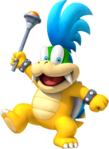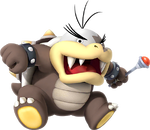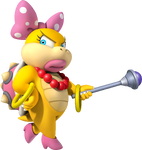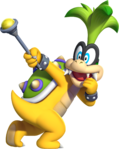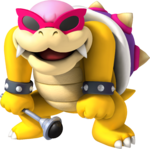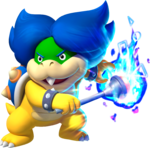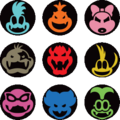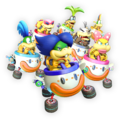Koopalings
- Not to be confused with Koopa Kid.
- "Little Koopa" redirects here. For the miniature variant of Koopa Troopa, see Small Koopa Troopa.
| Koopalings | |||
|---|---|---|---|
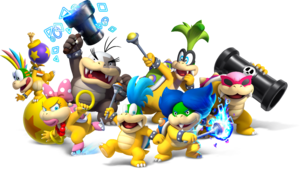 Full group artwork of the Koopalings for New Super Mario Bros. U | |||
| First appearance | Super Mario Bros. 3 (1988) | ||
| Latest appearance | Nintendo World Championships: NES Edition (2024) | ||
| Member of | Bowser's Minions | ||
| |||
| |||
- “We just love being mean!!”
- —Koopalings, Super Mario Bros. 3 instruction booklet
The Koopalings, also known as Bowser's Minions in the British English versions of some games, and in certain American works as the Koopa Kids, are a seven-member clan of recurring enemies in the Super Mario franchise, portrayed as siblings[1][2] who act as leaders of Bowser's Minions under Bowser. Individually, they are named Larry, Morton, Wendy, Iggy, Roy, Lemmy, and Ludwig. Although Bowser Jr. is not a member of the Koopalings, they sometimes act as his personal minions, and he is often seen accompanying them.
The Koopalings debuted in Super Mario Bros. 3, and they later appeared as bosses in various SNES-era games of the Super Mario franchise before going on a long hiatus, reappearing once in 2003's Mario & Luigi: Superstar Saga, and then being redesigned for 2009's New Super Mario Bros. Wii, which has since been followed by numerous appearances as both bosses in the platformers of the Super Mario series and playable characters in various spinoffs. They have also appeared in various other media, including the cartoon The Adventures of Super Mario Bros. 3, which featured entirely different names for the characters due to them not having official names at the time of its production phase.
Originally, the Koopalings were depicted as Bowser's children[3][4][5][6][7] and stated to be his offspring.[8][9][10][11][12] Older games continue to maintain them as his children in re-releases and updated manuals.[13][14][15][16][17] However, Shigeru Miyamoto eventually affirmed that Nintendo's "current story is that the Koopalings are not Bowser's children" in 2012, leaving the Koopalings as his underlings and Bowser Jr. as his only child.[18]
Members
The Koopalings are listed below in their original order:
| Larry Koopa | Larry Koopa is the youngest Koopaling who is often seen at the forefront of the Koopalings' antics, and he wields the orange magic wand. His main color representation is sky blue, although his shell was originally colored green, his hair was white in early sprites, and he lacked the small star on the side of his face. There is some confusion over the identity of Larry's namesake; the most recent official statement from his christener, Nintendo of America employee Dayvv Brooks, is that Larry was named as such because he simply "looked like a Larry," though Brooks had previously stated that Larry's name was derived from Larry Mullen Jr., the drummer for the Irish rock band U2. He was also known as "Cheatsy" in the cartoons, alluding to the fact that he will try to win by any means, legitimate or otherwise. He seems to have an interest in sports, such as how he plays tennis with a fireball in Mario & Luigi: Superstar Saga. In the Nintendo Comics System, he communicated via pictures in word bubbles, which only Lemmy understood. |
| Morton Koopa Jr. | Morton Koopa Jr. is the only Koopaling to have a brown skin tone and is often depicted as the largest Koopaling, wielding the red magic wand. His main color representation is black, although his shell was colored green, his skin was yellow in Super Mario World, and he lacked the distinctive star on his face in his early in-game sprites. He is named after the American tabloid talk show presenter Morton Downey, Jr. He was also known as "Big Mouth" in the cartoons, due to his talkative nature, and often talks for long amounts of time, only to be stopped by another character, most often one of his siblings. In other appearances, he seems to be rather grouchy, with brutal strength to match. Morton's level of intelligence is portrayed inconsistently; sometimes he is shown to be quite slow-witted, but in other games, he possesses a more cunning side. |
| Wendy O. Koopa | Wendy O. Koopa is the sole female Koopaling; she wields the purple magic wand. Her main color representation is pink, although her shell was a shade of deep red in Super Mario World. She is named after Wendy O. Williams, an American singer and frontwoman of the punk rock band the Plasmatics. She was also known as "Kootie Pie" in the cartoons and was considered a spoiled brat with a quick temper, often going into a rage over little things. She is stated to be tomboyish, and seemed to act as the de facto boss in Super Mario Adventures. |
| Iggy Koopa | Iggy Koopa is a hyperactive, demented, and unpredictable Koopaling who wields the yellow magic wand. His main choice of color is yellow-green, although his shell was colored blue in early sprites and his hair was white in Super Mario World; before New Super Mario Bros. Wii, his hair was also similar to Lemmy's. He is named after Iggy Pop, an American rock musician and frontman of the proto-punk band the Stooges. He was also known as "Hop" in the cartoons and is the twin brother of Hip (Lemmy); together, they are among the youngest members of the family. He was just as childish and immature as his brother in the cartoon series, whereas in the Nintendo Adventure Books he was depicted as a brilliant (if crazed) inventor; this has possibly been hinted at in New Super Mario Bros. U, where the inside of his ship is mechanical rather than wooden. |
| Roy Koopa | Roy Koopa's head and sunglasses are pink (as was his shell originally), and he wields the black magic wand. His main color representation is purple, although his shell and head were colored lavender-purple in Super Mario World. He is named after American rock & roll singer Roy Orbison. He was also known as "Bully" in the cartoons and is said to be a typical bully who likes beating up others for his own amusement. This is true in most appearances, but in certain Japanese materials, Roy instead speaks in a calm and collected manner, so he may have more of a laid-back personality and be less of a tough guy. He is also the second bulkiest Koopaling after Morton. |
| Lemmy Koopa | Lemmy Koopa is depicted as a small, fun-loving child who wields the green magic wand and has been shown capable of being serious when the situation calls for it. His main color representation is orange. Although in Super Mario World, his shell was colored yellow and his hair was white, and his shell was originally green and he lacked the ponytail. He is named after the late Lemmy Kilmister, frontman of the English heavy metal band Motörhead. He was also known as "Hip" in the cartoons and is the twin brother of Hop (Iggy); together, they are among the youngest members of the family. Lemmy is usually depicted as perhaps the least bright Koopaling, but is also the most genuinely innocent of his siblings. |
| Ludwig von Koopa | Ludwig von Koopa is the eldest[19] who possesses a magnificent intelligence most likely superior to that of the other Koopalings, and wields the blue magic wand. His main color representation is deep blue, although he was originally depicted with a green shell in artwork (aqua-blue in Super Mario Bros. 3 and yellow in Super Mario World), as well as white hair in early sprites. He is named after the German Classical and Romantic late composer Ludwig van Beethoven. He was also known as "Kooky" in the cartoons and had more of a mad scientist persona. Like his namesake, he is said to be a composer and is very much into the culture, but is also sometimes suggested to be the cruelest of the Koopalings. According to Mario & Luigi: Paper Jam, Ludwig egotistically believes himself to be a "real leader", to which the others, Lemmy, Morton, and Iggy specifically, claim they never voted on it and further explain they operate as a collective trust.[20] |
In addition, the Prima Games guide of Super Mario Advance 4: Super Mario Bros. 3 refers to Boom Boom as a Koopaling,[21] despite listing him separately in the Friends and Foes section.
Concept and creation
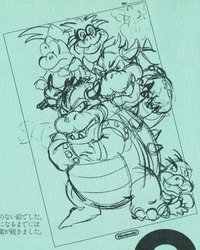
One of the first sketches in which the Koopalings can be seen, a result of the collaboration between Yoichi Kotabe and Takashi Tezuka, happened before the release of the Family Computer Disk System version of Super Mario Bros.: The Lost Levels in 1986 and is associated with Bowser's first redesign.[22] The Koopalings were modeled after the design team of Super Mario Bros. 3,[23] and they were all named after famous musicians by the game's North American localizers,[24] since they were not given distinct names in the original Japanese version.[25] In the Japanese version of Super Mario World, only their first names were adopted, dropping the Koopa surname,[26] as was done in many subsequent games (both in English and Japanese). The Koopalings were all given different names in the cartoons, purportedly because Nintendo of America had not released their own names yet, forcing the writers of The Adventures of Super Mario Bros. 3 to come up with their own names.
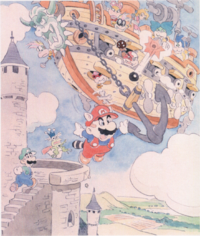
The word "Koopaling" itself is likely a combination of the name "Koopa" with the diminutive suffix "-ling", which is often used to denote a younger, smaller or inferior version (such as the word "duckling" being used to describe the juvenile version of a duck), which aptly describes their relation to Bowser. Similarly, their original Japanese name, "Kokuppa" is essentially "Little Koopa" (which is what the retainers serving the kings call them in the NES and SNES versions) or "Child Koopa", with Koopa being the Japanese name of Bowser. Interestingly, only their Italian name, Bowserotti, actually means Little Bowsers using the Western name of Bowser, with the names in the other languages leaving the Koopa word intact, even when it does not specifically mean Bowser. The English name also evokes such words as "fledgling", "hatchling", "youngling", or even "underling", and may be a mere portmanteau between one of them and "Koopa".
History
- Main article: History of the Koopalings
Since their debut in Super Mario Bros. 3, the Koopalings are notable for appearing as world bosses across Super Mario platformers. In some role-playing games including the Mario & Luigi and Paper Mario series, they also appear as bosses. The Koopalings appear as separate playable characters in some spin-offs. They appear in other Super Mario media under different names when they did not have their official names during production.
General information
Physical appearance

All the Koopalings look relatively similar to Bowser and Bowser Jr., but lack horns on their head. Morton has a unique darker complexion, and three have heads that are not green in coloration (Morton's head is white and Roy's is pink while Wendy's head matches the rest of her body's yellow coloration). Three of them (Larry, Wendy and in part Iggy) have blue eyes much like Bowser in Super Mario Bros. 3 (but while Bowser's eyes were changed to red, the Koopalings' eyes remained blue). Originally, Ludwig, Morton and Lemmy's eyes were merely black dots, however the former two have since been shown to have thin dark gray irises. All of them have pointed claws on their hands. All the Koopalings have various distinguishing features, such as varying numbers of teeth protruding from their snouts and unique hair styles and colors. Oddly, their sprites in Super Mario World and the Super Mario Bros. 3 remake in Super Mario All-Stars gave them all white hair and coloration that did not match their artwork, carrying over from the original, inaccurate color palette from the NES. All of them, like Bowser, have ribbed plated bellies. Although the Koopalings were shown in the sprites to have at least four spikes on their shells, the cover for Nintendo Power Player's Guide for Super Mario All-Stars showed them, or at least Morton and Roy, only having three spines, all of which were directly on the center of the shell from top to bottom. In addition, while Lemmy does not have fangs, his in-game depiction in Super Mario World does.
While most of the Koopalings originally had green shells, redesigns introduced with New Super Mario Bros. Wii gave them all unique shell colors. Other aspects of their pre-existing designs were also tweaked, such as Iggy's hair being green rather than multicolored in order to differentiate him further from Lemmy, and their heights and builds being more varied, with Morton now the tallest, followed by Iggy, Roy, Ludwig, Wendy, Larry and finally Lemmy, who was the runt of the litter in their original appearances as well. Their tails also became visible in their official artwork starting from New Super Mario Bros. Wii, having not been drawn until then[27] except for some sprite depictions and an artwork which apparently shows Iggy's tail.[28] In their playable appearances in the Super Smash Bros. series, because they are model swaps of Bowser Jr., all of the Koopalings appear roughly the same height as one another, most notably with Roy, Iggy, Morton and Lemmy (although Iggy is still thin).
The Koopalings' designs were modified in the DIC cartoons, although they were still recognizable.
Personalities
The Koopalings' individual personalities have not been fleshed out much besides being childlike, their desire to cause mayhem, and their loyalty to Bowser. However, there were some hints in various supplementary materials. Some of the personalities changed between localizations. For example, Roy in the North American localizations was depicted in a manner similar to a bully (which also earned him the name "Bully" in the DIC cartoons), but the Japanese Super Mario Bros. 3 instruction booklet and Super Mario Advance 4 e-Reader cards give him a calm and collected demeanor. The original manual also gave each of the Koopalings several quirks unique to each of them that hinted at their individual personalities with some speeches uttered by them; however, the official English translation toned down several of these quirks or removed them altogether. Although loyal to Bowser, they also did not wish to be on the receiving end of Bowser's rage if they failed a task, as evidenced by Larry's reason for why he and the other Koopalings will not give up the kings' wands easily to Mario, as he stated that the alternative would be to get yelled at by Bowser. Prior to their modern depictions, they were given distinguishing characteristics in The Adventures of Super Mario Bros. 3 and the Super Mario World cartoon, as well as the Nintendo Comics System and Nintendo Adventure Books. In Mario Kart 8, the Koopalings seem to have better speech capabilities than Bowser, as they can be heard saying their names at several points, and even yelling one or two-liners. In addition to being childlike, a Play Nintendo quiz describes the Koopalings as "zany".[29]
The Koopalings' loyalty to Bowser is strong enough that they are willing to serve him even when "Bowser" is actually not himself and in fact possessed by another figure. This is implied by their servitude to Bowletta in Mario & Luigi: Superstar Saga and later confirmed in Paper Mario: Color Splash, where Wendy and Larry specifically mention doing their actions for Bowser and Morton indirectly says that as well despite Bowser being under the influence of black paint. In the former game's remake, they also possessed strong enough wills that Fawful, when brainwashing them with his spray, was ultimately forced to use a maximum potent dosage on them to sway them to his side.
They were also willing to work with Bowser's son, Bowser Jr., and had little problem with him, as implied by Roy Koopa briefly calling him squirt (Young Master in the Japanese version) and overall talking to him in a casual nature. However, Bowser Jr.'s Journey indicated that even they have their limits when working with Bowser Jr., as many of them ended up quitting on him due to being fed up with his notoriously selfish nature while they were trying to hunt for the remedy for the blorbs, the only real exceptions being Iggy and Morton, the former being forced to leave by Bowser Jr. due to finding him annoying, and the latter ended up brainwashed by the Best Fitness Friends into attacking Bowser Jr..
Abilities
The Koopalings each have varying abilities, but in general, the Koopalings are capable of using their shell as both a method of defense and a method of offense. In addition, they are all capable of jumping very high, and are all skilled in magic, frequently using magic wands as a weapon. While only Ludwig, Iggy, and Larry spat fireballs in Super Mario World, Mario & Luigi: Superstar Saga revealed that all Koopalings have this ability. Despite that, they are weak to fireballs, though their exact limit has varied between taking multiple fireballs to take down, or being one-hit knocked out by a single fireball. Similar to Bowser, they also have a tendency to survive dangerous hits. This is especially evident with their defeat in Super Mario World, where Larry, Wendy, Iggy, and Lemmy were dunked into lava by the Mario Bros., and each Koopaling later had their castles collapse on them, in New Super Mario Bros. Wii where they, alongside Bowser and Bowser Jr., ended up surviving being crushed by Bowser's falling castle, and in New Super Mario Bros. 2, where all of them were accidentally knocked into the lava twice (once by a gigantic Bowser, and then by a gigantic Dry Bowser). Their fighting prowess was such that they managed to casually knock away several Beanies while discussing how they can find Bowser at the same time in Mario & Luigi: Superstar Saga + Bowser's Minions.
In terms of talents unique to individual Koopalings, they seem to know their own spells. While most of them simply cast a colorful shot of magic that slowly flies in a straight line, Wendy instead creates glowing rings that ricochet off the surfaces of the room, and Lemmy creates bouncing circus balls that can knock the Mario Bros. into a bottomless pit. In every game appearance outside of Super Mario World, Lemmy is always seen in battle balancing on top of a big yellow circus ball covered with starry patterns. Ludwig could create earthquakes with his descents in Super Mario Bros. 3, an ability that was taken away from him ever since New Super Mario Bros. Wii, but kept by Roy and Morton. Ludwig was given the ability to flutter jump in the New Super Mario Bros. games instead. In Super Mario World, Roy and Morton were able to walk up walls and ceilings and drop down at will.
Family relationship
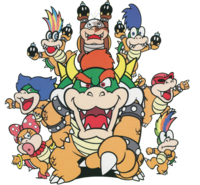
In their first appearance in Super Mario Bros. 3, the Koopalings were introduced as siblings and Bowser's own children.[30][4][3] Most re-releases and remakes of this 1988 game as well as republications of the game's story retain this detail in Japan, including the 2013 Nintendo 3DS Virtual Console release.[13][14][31] However, the 2007 Japanese Wii Virtual Console version's manual does not mention their relationship to Bowser,[32] and the 2015 Japanese Encyclopedia Super Mario Bros. uses a less strong statement than the one found in the original manual.[2] The 2018 English and French versions of Encyclopedia Super Mario Bros. preserve the original manual's description of the Koopalings being Bowser's children verbatim,[17][33] while the German and Spanish translations of said book make no mention of their relationship.[34][35] Translations of Super Mario Bros. 3, its re-releases, remakes, official guides, and websites have kept this detail to varying degrees, with most calling the Koopalings Bowser's offspring.[36][37][38][8][9][10][11][39] The 1990 cartoon based on the game, The Adventures of Super Mario Bros. 3, follows this portrayal, with the Koopalings referring to Bowser as "king dad".[40]
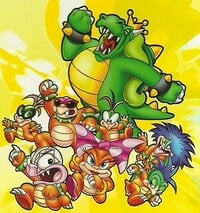
The 1991 Super Mario World English manual,[5] the Japanese Nintendo Official Guidebooks for both the original and 2001 Super Mario Advance 2: Super Mario World remake,[41][15] and related 1990 Japanese materials state that the Koopalings are Bowsers' children,[6] while the in-game text and Japanese manual (as well as its re-releases and remakes) do not make any direct statements about their relationship. In three character books written with the involvement of Nintendo, the Koopalings are considered Bowser's children, and in two cases explicitly stated to be members of his royal family (「
The back of the English Yoshi's Safari box calls them Bowser's "offspring" in 1993, and the French translation of said text uses the same term as well,[12] which is absent in the Japanese manual.[45]
The manual for the SNES version of Mario is Missing! vaguely describes the Koopalings as Bowser's "bad boys",[46] although in the DOS version's in-game dialogue, the Koopalings refer to Bowser by name rather than with a familial title. In Super Smash Bros. Melee, Bowser's seven children are mentioned in both the Japanese and English versions,[7] and this relationship is also mentioned in the Super Mario Advance series from 2001 to 2003.[15][39]
Following the introduction of Bowser Jr. in 2002, who is treated independently from the Koopalings, and the lack of major appearances from the Koopalings between Mario & Luigi: Superstar Saga in 2003 and New Super Mario Bros. Wii in 2009, there was confusion about the nature of Bowser's parenthood. Bowser Jr. was first implied to have replaced the Koopalings as Bowser's sole child in the description of Bowser's trophy in Super Smash Bros. Brawl, the Japanese version of which refers to Bowser Jr. as「ひとり息子」, meaning "one son" or "only son".[47] While the Koopalings and Bowser Jr. appear together in New Super Mario Bros. Wii, official websites refer to the Koopalings as Bowser's minions rather than his children, and as each other's comrades rather than siblings;[48][49] however, the game's Prima guide refers to the Koopalings and Bowser Jr. collectively as Bowser's children, and considers Bowser Jr. to be a Koopaling himself.[50][51] In a September 2012 interview, Shigeru Miyamoto, speaking with Takashi Tezuka, stated that the "current story is that the seven Koopalings are not Bowser's children", leaving Bowser Jr. as his only child (with an unknown mother).[18] In the Japanese Nintendo Direct announcing the Koopalings as playable characters in Mario Kart 8, they are described as「クッパ
In Mario & Luigi: Paper Jam, the Koopalings have lines of dialogue, which would later continue in games such as Mario & Sonic at the Rio 2016 Olympic Games, Paper Mario: Color Splash, Mario & Luigi: Superstar Saga + Bowser's Minions, Mario & Luigi: Bowser's Inside Story + Bowser Jr.'s Journey, and Mario & Sonic at the Olympic Games Tokyo 2020. To reflect their revised portrayal, in the Japanese versions of the games, the Koopalings refer to Bowser as Master Bowser (「クッパ
The Japanese website of New Super Mario Bros. U Deluxe, besides referring to them using the newer Team of Seven Bowsers (「クッパ7人衆」) term instead of the original Bowser's Minions (「クッパの手下」) term, also indicates that they are considered as the leaders of the Bowser clan (「クッパ一味の幹部」).[62]
Birth order
In Nintendo Power, Larry was stated to be the youngest of the Koopalings[63] (reaffirmed as still true in his trophy description in the American version of Super Smash Bros. for Wii U and his character origin tip in Super Smash Bros. Ultimate), while Ludwig was said to be the oldest.[19] The birth order for the five middle children was not confirmed, although in Super Mario Bros. 3, as Larry is the first Koopaling to be fought and Ludwig is the last, the implication would seem to be that all seven Koopalings are fought in order from youngest to oldest (provided the player does not warp); however, Morton is described as "one of the older Koopalings" in the Super Mario Bros. 3 Nintendo Power Strategy Guide,[64] although this may have been in relation to Larry, the previous boss encountered. The Prima strategy guide for Super Mario Advance 4: Super Mario Bros. 3 describes Roy as being "a little heavier than his younger family", which might indicate that Roy is one of the older Koopalings.[65] In Super Mario World! Yoshi no Tamago, Morton calls Wendy「あねご」(anego, "older sister").[66]
In The Adventures of Super Mario Bros. 3, Hip and Hop (Lemmy and Iggy) are depicted as twins and are contradictorily believed to be the youngest. Although Kootie Pie (Wendy) celebrated her sixteenth birthday in "Reptiles in the Rose Garden", the specific ages of the others was never confirmed. According to the Writer's Bible included on the Shout! Factory DVD set and brief concept clips of the cartoon, the other Koopalings were all teenagers; Bully (Roy) was the eldest, followed by Big Mouth (Morton), Kooky (Ludwig), Cheatsy (Larry), Kootie Pie, and finally Hip and Hop both at six years old. This is seemingly the reference used for the Nintendo Adventure Books series, since in Leaping Lizards, Morton exclaims, "Little brothers are so cowardly!" in regards to Iggy, although this may have been a quip at Luigi's expense (who expressed particular resentment at that remark).
Leadership
The Super Mario Bros. 3 Nintendo Power Strategy Guide also states that Ludwig is Bowser's second in command,[19] effectively making him the leader of the Koopalings. Since then, this role has been supplanted by characters such as Kammy Koopa, Kamek, and Bowser Jr. The American English version of Super Smash Bros. for Nintendo 3DS and the European English version of Super Smash Bros. for Wii U state that Larry leads the Koopalings and Bowser's Minions respectively, although both are inaccurate translations of the original Japanese description, which simply states that Larry is one of the seven Koopalings and the leader of a special unit in Bowser's Minions.[67] In Mario & Luigi: Paper Jam, Larry calls Ludwig "boss", and Ludwig shows that he thinks of himself as a leader, and even a king, both of which are contested by other Koopalings.
Fighting order
The order the Koopalings are fought differ in each game they appear as bosses:
| Game | First | Second | Third | Fourth | Fifth | Sixth | Seventh |
|---|---|---|---|---|---|---|---|
| Super Mario Bros. 3 / Monopoly Gamer | Larry | Morton | Wendy | Iggy | Roy | Lemmy | Ludwig |
| Super Mario World / Mario & Luigi: Superstar Saga | Iggy | Morton | Lemmy | Ludwig | Roy | Wendy | Larry |
| Yoshi's Safari | Lemmy | Ludwig | Wendy | Larry | Morton | Iggy | Roy |
| Hotel Mario | Morton | Roy | Larry | Lemmy | Ludwig | Wendy | Iggy |
| New Super Mario Bros. Wii | Larry | Roy | Lemmy | Wendy | Iggy | Morton | Ludwig |
| New Super Mario Bros. 2 | Roy | Iggy | Larry | Wendy | Morton | Lemmy | Ludwig |
| New Super Mario Bros. U / New Super Luigi U | Lemmy | Morton | Larry | Wendy | Iggy | Roy | Ludwig |
| Puzzle & Dragons: Super Mario Bros. Edition | Larry | Lemmy | Morton | Wendy | Iggy | Roy | Ludwig |
| Paper Mario: Color Splash | Morton | Iggy | Ludwig | Wendy | Larry | Lemmy | Roy |
| Minion Quest: The Search for Bowser | Larry | Iggy | Wendy | Morton | Roy | Lemmy | Ludwig |
Footnotes
- Due to the world structure of New Super Mario Bros. 2 (six main worlds and three optional special worlds), Worlds Mushroom and Flower (and their Koopalings, Larry and Lemmy) can be considered either to be preceded by World 6 (Bowser) or succeeded by Worlds 3 (Wendy) and 5 (Ludwig), respectively.
- Even though Sparkling Waters and Frosted Glacier are officially considered to be the third and fourth worlds of New Super Mario Bros. U (and New Super Luigi U), respectively, the player can choose to beat whichever one (and their Koopalings, Larry and Wendy) first. Similarly, while all the levels are numbered in Yoshi's Safari, the player can play them in any order they wish.
- Mario & Luigi: Paper Jam has the player fighting two or three of the Koopalings at once, with Roy and Wendy, then Larry and Ludwig, then Morton and Lemmy via Papercraft; then each pair is fought again, with Morton and Lemmy joined by Iggy. The first two pairs are also fought alongside Dry Bowser.
- In the SNES version of Mario is Missing!, only Ludwig, Iggy, and Roy are fought, with Larry, Morton, Wendy and Lemmy only being depicted in the manual. In the DOS version, however, all except for Morton and Lemmy appear (although the latter two were planned to appear, at least in the CD-ROM Deluxe edition, due to the presence of unused voice clips), and they are fought in the following order: Larry, Roy, Wendy, Iggy and Ludwig.
- In Minion Quest: The Search for Bowser, Lemmy and Ludwig are both fought in the same level, albeit in different waves (Lemmy comes two waves before Ludwig). All the Koopalings are fought again at the same time later in the game, with Ludwig as the captain and the rest as regular troops.
- Although Monopoly Gamer is technically not a video game, the Koopalings nonetheless act as "bosses" for each deck. The order they are fought in is the same as in Super Mario Bros. 3.
- In Bowser Jr.'s Journey, Larry is fought first, then Iggy and Wendy are fought in the same level; Wendy is the fought one wave before Iggy, before fighting together in the last wave where Iggy is the first officer and Wendy is the captain, and Iggy is fought again later in the game, followed by Roy, and finally Morton. Ludwig and Lemmy are never fought. Dark versions of the Koopalings are fought alongside the final boss, as well as in the final post-game level Beat the Minions!
- In the Nintendo 3DS version of Mario & Sonic at the Rio 2016 Olympic Games, Roy is faced in the second day of the Super Mario campaign, Larry is encountered in the fourth day of the Sonic campaign, and Wendy is challenged in the sixth day of the Super Mario campaign. Once again, in Mario & Sonic at the Olympic Games Tokyo 2020, during the story mode, only three Koopalings appear: Wendy is challenged first, followed by Larry and finally Ludwig.
Portrayals
Although the games themselves initially did not have the Koopalings speak (the DOS version of Mario is Missing! nonwithstanding), the Koopalings did have a variety of voice actors in various Mario media.
In Amada Anime Series: Super Mario Bros., the Koopalings were voiced by Masaharu Satō (Larry and Iggy), Miyako Endō (Morton and Wendy), and Naoki Tatsuta (Roy, Lemmy, and Ludwig).
In the DIC cartoons, the Koopalings were voiced by James Ransken (Cheatsy), Gordon Masten (Big Mouth), Tabitha St. Germain (Kootie Pie), Tara Charendoff (Hop), Dan Hennessey (Bully), Stuart Stone (Hip), and Michael Stark (Kooky).
The Koopalings appeared in the interactive anime video Super Mario World: Mario to Yoshi no Bōken Land, and there they were given spoken dialogue. Their voice actors were not credited.
In Mario is Missing!, the Koopa Kids, as noted above, were given dialogue. In the CD-ROM Deluxe version, Larry, Iggy and Ludwig were voiced by Rob Wallace, Wendy was voiced by Kathy Fitzgerald, and Roy was voiced by Bruce Sandig, who also voiced the unused clips of Lemmy.[68]
In Super Mario Advance 2: Super Mario World, the Koopalings did have voices, although they just gave dying screeches when defeated by Mario or Luigi. Additionally, they were all similar monster roars, and only Iggy, Lemmy, Wendy and Larry used them.
Starting with 2009's New Super Mario Bros. Wii, the Koopalings were given in-game voice acting, although it was largely composed of grunts and roars instead of actual dialogue. Larry, Morton, Wendy and Lemmy are voiced by Lani Minella, Iggy and Ludwig are voiced by Mike Vaughn, and Roy is voiced by Dan Falcone.
From Mario Kart 8 onwards, all the Koopalings, except for Roy, are voiced by new voice actors, with Morton, Ludwig, Iggy, Wendy, Larry and Lemmy being voiced by David Cooke, David J. Goldfarb, Ryan Higgins, Ashley Flannegan, Michelle Hippe and Carlee McManus respectively. This time, they do say actual words and phrases, besides their "No!" yells when defeated in the former games.
In Super Smash Bros. for Nintendo 3DS, Super Smash Bros. for Wii U, and Super Smash Bros. Ultimate, the Koopalings have reused their voice samples from New Super Mario Bros. Wii.
In Mario & Luigi: Paper Jam, the Koopalings have spoken dialogue for the first time since the Mario's Early Years! series. Their voice clips, however, are reused from Mario Kart 8.
In Paper Mario: Color Splash, the Koopalings again have spoken dialogue.
Although the Koopalings never actually spoke in the initial release of Mario & Luigi: Superstar Saga beyond uttering roars, they were given dialogue in Mario & Luigi: Superstar Saga + Bowser's Minions in the alternate story mode Minion Quest: The Search for Bowser, and to a lesser extent in the main game itself (although only Iggy, Ludwig, and Roy are actually seen speaking during this time). The voice clips are again the ones recorded for Mario Kart 8, and they are used in the Bowser Jr.'s Journey mode of Mario & Luigi: Bowser's Inside Story + Bowser Jr.'s Journey, in which the Koopalings have spoken dialogue.
Profiles
Super Mario World
- Mario Mania: Morton, Lemmy, Larry, Iggy, Wendy, Ludwig and Roy are the messiest, rowdiest, meanest kids imaginable which makes their pop, the King of the Koopas, mighty proud. Their philosophy is "divide and conquer," and they carry it out by spreading throughout their land of choice and each setting up their own impenetrable fortress.[69]
New Super Mario Bros. 2
- North American website bio: These crooked minions of Bowser await at the end of each world. Watch out—each have their own unique ways of causing trouble for Mario.
Mario Kart Tour
- Mario Kart Tour Twitter: Bowser Jr. may have joined the race, but he didn't come alone! He brought a few friends along with him, including Lemmy, Wendy, Ludwig, Roy, and the rest of the Koopalings! They each have their own special skills, so be sure to try them all![70]
Gallery
- For this subject's image gallery, see Gallery:Koopalings.
Naming
In the Japanese versions, the Koopalings have been referred to by several names, all of which are derived from Bowser's Japanese name,「クッパ」(Kuppa or "Koopa"). Some of their names also integrate the character「コ」; it is ambiguous whether this character represents「子」(ko-, "child") or「小」(ko, "young").「コクッパ」can thus mean "Little Koopa", "Child Koopa", "Young Koopa", etc. A rare variant of this phrase,「子クッパ」, is seen on the back of the Japanese Super Mario Bros. 3 box and in the Nintendo Official Guidebook of Super Mario All-Stars. "7" or「七」, when used with「人」to count people, is read as shichi; otherwise it is commonly read as nana. In the English versions of Super Mario Bros. 3 except for Super Mario Advance 4: Super Mario Bros. 3, Toad refers to the Koopalings as "Little Koopa" if a castle is visited after losing an airship level. Starting with New Super Mario Bros. Wii, PAL territories refer to the Koopalings as "Bowser's minions" to match concurrent Japanese material,[71] although American versions continue to use "Koopalings" instead.[72] These names were eventually unified as of Mario Kart 8, where Japanese versions use a variant of their name from Super Famicom material, while all English versions use the "Koopalings" term.
Names in other languages
Names used in most media
The contemporaneous name for each language is listed first. Subsequent names are listed in chronological order for each language, from oldest to newest, and have the media they are associated with in the "Notes" column.
| Language | Name | Meaning | Notes |
|---|---|---|---|
| Japanese | クッパ7人衆[73][74][75][76] Kuppa 7 Ninshū |
Team of 7 Bowsers | |
| 子クッパ7兄弟[77] Kokuppa 7 Kyōdai |
7 Little Bowser Siblings | Super Mario Bros. 3 | |
| コクッパ7兄弟[78] Kokuppa 7 Kyōdai | |||
| コクッパ7人衆[79] Kokuppa 7 Ninshū |
Team of 7 Little Bowsers | Super Mario World | |
| 子クッパ7人衆[80] Kokuppa 7 Ninshū |
Super Mario All-Stars | ||
| コクッパ軍団[?] Kokuppa-gundan |
Little Bowser Corps | Mario & Luigi: Superstar Saga | |
| クッパの手下[81] Kuppa no Teshita |
Bowser's Minions; occassionally applied to his army | New Super Mario Bros. Wii | |
| クッパ七人衆[82] Kuppa Shichi Ninshū |
Team of 7 Bowsers | Super Mario Bros. Encyclopedia | |
| Chinese (simplified) | 酷霸王帮众[83] Kùbàwáng Bāngzhòng |
Bowser Gang | |
| 酷霸王7人组[84][85] Kùbàwáng Qīrénzǔ |
Team of 7 Bowsers | Super Smash Bros. Ultimate, New Super Mario Bros. U Deluxe | |
| 酷霸王7人帮[86] Kùbàwáng Qīrénbāng |
Bowser Gang of Seven | Super Mario Maker 2 | |
| Chinese (traditional) | 庫巴7人幫[87][88] Kùbā Qīrénbāng |
Bowser Gang of Seven | |
| 庫巴的小魔頭們[89] Kùbā de Xiǎomótóumen |
Bowser's Little Bosses | New Super Mario Bros. 2 | |
| 庫巴7人衆[90][91] Kùbā Qīrénzhòng |
Team of 7 Bowsers | Super Smash Bros. Ultimate, New Super Mario Bros. U Deluxe | |
| 小庫巴7兄弟[92] Xiǎo Kùbā 7 Xiōngdì |
7 Little Bowser Siblings | Super Mario Bros. 35th Anniversary | |
| Dutch | Koopalings[93] | - | |
| Bowser's kinderen[94] | Bowser's children | Super Mario Bros. 3 | |
| Koopa Kids[95] | - | Super Mario World | |
| Finnish | Koopanuoriso[96] | From nouriso ("youth", young people collectively) | |
| French (NOA) | Koopalins[73] | From "Koopalings" | |
| Fils de Bowser[97]:30 | Bowser's children | New Super Mario Bros. Wii | |
| French (NOE) | Les Terreurs de Bowser[98] | Bowser's Terrors | |
| Enfants de Bowser[94] | Bowser's children | Super Mario Bros. 3 | |
| Marmots Koopas[95]:19 | Koopa Brats | Super Mario World | |
| Koopalings[99] | - | Hotel Mario | |
| Koopas[100]:52 | Koopas | Super Mario Advance 4: Super Mario Bros. 3, Mario & Luigi: Superstar Saga | |
| Sbires de Bowser[73] | Bowser's minions | New Super Mario Bros. Wii, Super Smash Bros. for Nintendo 3DS / Wii U | |
| German | Bowsers Schergen[101][73] | Bowser's Minions | |
| Bowser's Kinder[102][103] | Bowser's Children | Super Mario Bros. 3 | |
| Koopas[100]:32 | - | Super Mario Advance 4: Super Mario Bros. 3 | |
| Italian | Gli scagnozzi di Bowser[104] | Bowser's minions; occasionally applied to his army | |
| Figli di Bowser[105] | Bowser's children | Super Mario Bros. 3 | |
| Koopa Kids[106] | - | Super Mario World | |
| Koopaling[107] | Super Mario All-Stars | ||
| Bowserotti[100]:106 | Little Bowsers; from "Bowser" and the diminutive suffix -otti | Super Mario Advance 4: Super Mario Bros. 3 | |
| Korean | 쿠파7인조[108] Kupa 7(chil)injo |
Team of 7 Bowsers | |
| 바우저의 자녀들[109] Baujeoui Janyeodeul |
Bowser's Children | Super Mario Bros. 3 | |
| 쿠파의 부하들[110] Kupa-ui Buhadeul |
Bowser's Minions | New Super Mario Bros. Wii | |
| 꼬마쿠파 7형제[111] Kkoma-Kupa 7-hyeongje |
7 Little Bowser Siblings | Super Mario All-Stars Limited Edition | |
| Portuguese (NOA) | Capangas Koopa[112][113] | Koopa minions | |
| Filhos do Koopa[114] | Koopa's children | Super Mario World | |
| Portuguese (NOE) | Bowsões[115][116] | Portmanteau of "Bowser" and mauzões ("bad guys") | Mario & Luigi: Paper Jam |
| Lacaios do Bowser[117] | Bowser's Minions | ||
| Russian | Купалинги[?] Kupalingi |
Koopalings | |
| Spanish (NOA) | Koopalines[97]:52[73] | Koopalings | |
| Koopalings[118] | - | Club Nintendo | |
| Spanish (NOE) | Esbirros de Bowser[73] | Bowser's henchmen | |
| Niños de Bowser[119] | Children of Bowser | Super Mario Bros. 3 | |
| Koopa Kids[120] | - | Super Mario World | |
| Swedish | Bowsers hantlangare[121] | Bowser's minions | |
| Koopaungarna[122] | From ungarna ("kids, cubs") | Super Mario Bros. 3, Super Mario World |
Names used in the DIC animated shows
| Language | Name | Meaning | Notes |
|---|---|---|---|
| Chinese (simplified) | 酷霸小子[123] Kùbà Xiǎozǐ |
Koopa Kids | |
| Croatian | Koopa Djeca[124] | Koopa Kids | |
| Danish | Koopa-Unger[125] | Koopa Kids | |
| Dutch | Koopa-Kinderen1[126] | Koopa Kids | |
| Koopajes2[126] | Diminutive of "Koopa" | ||
| Finnish | Koopanuoret[127] | Koopa Kids | |
| German | Koopalinge[128] | Koopalings | |
| Koopa-Brut[128] | Koopa's Brood | ||
| Italian | Piccoli Attila[129] | Little Koopas | |
| Norwegian | Koopa-Ungen[130] | Koopa Kids | |
| Polish | Dzieci Koopy[131] | Koopa Kids | |
| Portuguese | Koopalinhos[132][133] | From "Koopalings" with the diminutive suffix -inho | BKS and Herbert Richers dubs |
| Portuguese (NOA) | Filhos do Koopa[134] | Koopa Kids | Uniarthe dub |
| Portuguese (NOE) | Koopa Meninos[135] | Koopa Boys | Dialectus dub |
| Koopa Filhos[136] | Koopa Kids | Somnorte dub | |
| Romanian | Copiii Koopa[137] | Koopa Kids | The Adventures of Super Mario Bros. 3 |
| Koopișori[138] | Diminutive for "Koopa" | ||
| Aghiotanții lui Koopa[139] | Koopa's adjutants | Super Mario World (television series) | |
| Koopa aghiotanți[139] | Koopa adjutants | ||
| Russian | Купа для Детей[140] Kupa dlya Detey |
Koopa Kids | |
| Serbian | Koopa Deca[141] | Koopa Kids | |
| Slovenian | Koopa Otroci[142] | Koopa Kids | |
| Spanish (NOA) | Niños Koopa1[143] | Koopa Kids | Audiomaster 3000 dub |
| Koopaleles2[143] | Portmanteau of "Koopa" and peleles ("brats") | ||
| Hijos Koopa[144] | Koopa Kids | Intersound dub | |
| Spanish (NOE) | Niños Koopa[145] | Koopa Kids | |
| Swedish | Koopa-Ungar1[146] | Koopa Kids | |
| Koopalings2[146] | - |
1 - Replaces instances of "Koopa Kids" in the original
2 - Replaces instances of "Koopalings" in the original
Notes
- Larry is the only Koopaling to not have used Warp Pipes in any of his boss battles, with Lemmy and Wendy using them in Super Mario World, Roy using them in New Super Mario Bros. Wii, Morton and Ludwig using them in New Super Mario Bros. 2, and Iggy using them in New Super Mario Bros. U.
- In Mario & Luigi: Paper Jam, every Koopaling is associated with Battle Cards. Roy and Wendy are the first bosses on which Battle Cards can be used, Larry and Ludwig are the only bosses that can use their own Battle Cards, and Iggy, Morton, and Lemmy turn the player's Battle Cards into a special kind of Morton Battle Card, which either deals 60 damage to everyone, makes the player lose all of their star points, or gives the player a random Max Item.
References
- ^ As explained on the Koopalings' profile on the New Super Mario Bros. U official site. Archived February 3, 2013, 16:15:34 UTC from the original via Wayback Machine., as well as Larry's Super Smash Bros. for Wii U trophy
- ^ a b On page 33 of the Encyclopedia Super Mario Bros., there is this statement:「※取扱説明書のものをそのまま掲載しています。」; despite this, the part of the story where the Koopalings are introduced is this one:「さんざんこらしめたはずの大魔王クッパもマリオのいるキノコ王国からは手を引いたものの今度は子供コクッパ7兄弟を仲間に入れ、ワールドのあちこちでイタズラのやり放題。」; the「自分の」between「今度は」and「子供コクッパ7兄弟」, which roughly means "[Bowser's] own" and is present on page 4 of the original Japanese Super Mario Bros. 3 manual, is absent in this story. The meaning of the sentence is roughly unaltered, as this wording omitting the possessive pronoun has also been used in the Nintendo Official Guidebook of Super Mario World: Super Mario Advance 2 and Super Mario Advance 4: Super Mario Bros. 3, the latter of which also used the stronger form of the original story of Super Mario Bros. 3 showing the similar meaning of the two wordings, but the new one is less strong and explicit.
- ^ a b Super Mario Bros. 3 English instruction booklet. In the story section (page 5), they are called "Bowser's 7 kids" and "his 7 children", and Bowser's line (page 3) reads "Ha Ha Ha! These are my 7 children that are going to help me take over the Mushroom World!" The children are introduced with the phrase "These are Bowser's kids!!" (page 4). Larry (page 5), Morton (page 9) and Lemmy (page 34) refer to Bowser as their father or dad.
- ^ a b c In the Japanese instruction booklet of Super Mario Bros. 3, they are called「
自分 の子供 コクッパ7兄弟 」in the story section (page 4), and King Koopa's line (page 2) reads「ワッハハ。これから俺様 の息子達 がこのゲームの説明 をするぜ。息子達 の言 うことをよーく聞 いてせいぜいガンバルことだな。ワッハハ。」Note Koopa's use of「俺様 の息子たち 」(ore-sama no musuko-tachi), which equates to "my children" (or, literally, "my sons") while at the same time referring to himself in an arrogant manner. The children are introduced with the phrase「そして、これがコクッパ7兄弟 だ!!」(page 3). Larry (page 4), Morton (page 8) and Lemmy (page 34) refer to King Koopa as「オヤジ」(oyaji), which is both a Japanese word for "father" as well as a term of endearment. - ^ a b Super Mario World English instruction booklet, page 20 (Mysterious Sunken Ship description) "That's right, in Super Mario Bros. 3, Koopa and his kids used a flying ship to make life tough for Mario.".
- ^ a b Japanese card about the Koopalings in Super Mario World, in which they are referred to as「クッパ
大 魔 王 の7人 の息子 たち。」, meaning "The seven children of the (demon/sorcerer) king Bowser.". Note that their name is written with「7兄弟」instead of「7人衆」. - ^ a b In Super Smash Bros. Melee, the first trophy of Bowser in Japanese refers to him as having「7人のこども」.
- ^ a b Super Mario Bros. 3 Nintendo 3DS Virtual Console release. Nintendo of Europe (British English). Retrieved June 28, 2024. (Archived June 29, 2014, 17:18:22 UTC via archive.today.)
- ^ a b Super Mario Bros. 3. Nintendo of Italy (Italian). Retrieved June 28, 2024.
- ^ a b Super Mario Bros. 3. Nintendo of Germany (German). Retrieved June 28, 2024.
- ^ a b Super Mario Bros. 3. Nintendo of Benelux (Dutch). Retrieved June 28, 2024.
- ^ a b Back of the North American box of Yoshi's Safari.
- ^ a b A PDF manual for Super Mario Bros. 3 Nintendo 3DS Virtual Console release (March 2023 archive) available on the Nintendo of Japan eShop website, released January 1, 2013. (Retrieved February 15, 2013)
- ^ a b Nintendo Co., Ltd. (2003). Scans of the Japanese manual of Super Mario Advance 4. Retrieved December 23, 2015.
- ^ a b c Page 20 of the Japanese Nintendo Official Guidebook of Super Mario World: Super Mario Advance 2. The Koopalings are stated being「7
匹 の子ども=コクッパ」, roughly meaning (Bowser's) seven children=Koopalings using an implicit possessive pronoun. - ^ Super Mario Advance 4: Super Mario Bros. 3 Wii U Virtual Console release. Nintendo UK (British English). Retrieved June 28, 2024. (Archived March 21, 2023, 21:13:49 UTC via archive.today.)
- ^ a b Encyclopedia Super Mario Bros.. Page 47. "Bowser sent his seven children to make mischief as they please in the normally peaceful Mushroom World." (October 16, 2018)
- ^ a b "Our current story is that the seven Koopalings are not Bowser's children. Bowser's only child is Bowser Jr., and we do not know who the mother is." – Ryckert, Dan (September 10, 2015). Mario's Creators Answer Burning Questions About The Series. GameInformer (English). Retrieved June 28, 2024.
- ^ a b c "Bowser's oldest Koopaling and second in command, he's a real monster!" – June 1990. Super Mario Bros. 3 Nintendo Power Strategy Guide. Nintendo of America (American English). Page 9.
- ^ BeardBear (December 3, 2015). Mario & Luigi Paper Jam Walkthrough Part 27 | Neo Bowser Castle #5 & Bosses Koopalings. YouTube. Retrieved May 18, 2024.
- ^ "WORLD FORTRESSES Every world has at least one Fortress. This is usually a set of fearsome hallways guarded by nasties and always ends with a Koopa confrontation, courtesy of Boom Boom the Koopaling. Fortresses are just like regular levels, except that when you beat one, any nearby locks (usually preventing you from accessing pipes or Toad Houses) disappear." – Hodgson, David S J. (October 21, 2003). Super Mario Advance 4: Super Mario Bros. 3 Prima's Official Strategy Guide. Prima Games (American English). ISBN 0-7615-4425-9. Page 22.
- ^ Page 65 of the Japanese Official Nintendo Guidebook of Super Mario All-Stars. The caption states "At first Bowser's appearance was not entirely settled. In order to get to this version of the sketch, Kotabe and Tezuka collaborated multiple times". Note how the page is dedicated to the Famicom Disk System version of Super Mario Bros.: The Lost Levels, known as Super Mario Bros. 2 in Japan.
- ^ Interview with Shigeru Miyamoto in Mario Mania Player's Guide. Page 31.
- ^ As explained by Dayvv Brooks (former Nintendo of America employee), on July 18, 2012.
- ^ Super Mario Bros. 3 Japanese instruction booklet. Page 3.
- ^ Super Mario World: From Japanese to English. The Mushroom Kingdom (English). Retrieved June 28, 2024.
- ^ Mario kicking Wendy, Bowser and Ludwig, note how Bowser's tail is drawn while Ludwig's tail is not.
- ^ Main cast artwork for Super Mario Bros. 3 in which Iggy's tail can be seen.
- ^ https://play.nintendo.com/activities/quizzes/which-mario-kart-8-racer-are-you-most/ If you get Bowser.
- ^ A Japanese promotional pamphlet for Super Mario Bros. 3 The Koopalings are called「大魔王クッパの子供達」(Daimaō Kuppa no kodomo-tachi), which means "Great Demon King Koopa's children". The picture of this pamphlet is found in every version of Super Mario History 1985-2010 booklet except North American.
- ^ Scans of the original Japanese Super Mario Bros. 3 manual, hosted on Nintendo Co. Ltd. site. Retrieved November 10, 2016.
- ^ Super Mario Bros. 3 Wii Virtual Console website, released December 11, 2007.
- ^ On page 33 of the French translation of Super Mario Bros. Encyclopedia, in the story of Super Mario Bros. 3 it is told Bowser a envoyé ses sept enfants agir comme bon leur semble au sein du Monde des Champignons habituellement plutôt calme. (Bowser sent his seven children to act as they see fit within the usually rather calm Mushroom World). At page 144 in the general enemy description of New Super Mario Bros. Wii it is told Les sept frères et soeurs de la famille Bowser sont également présents[...] (The seven siblings of the Bowser family are also present).
- ^ An excerpt of page 33 of the German translation of the Encyclopedia Super Mario Bros., containing the story of Super Mario Bros. 3. The sentence Allerdings macht er sieben Koopalinge zu seinen Untertanen roughly means Indeed he turned seven Koopalings into his subjects.
- ^ Page 33 of the Spanish translation of the Encyclopedia Super Mario Bros., containing the story of Super Mario Bros. 3. The sentence Sin embargo, esta vez cuenta con la ayuda de los siete Koopalings, que hacen maldades por todas partes. roughly means Nonetheless, this time [he] has the help of the seven Koopalings, who cause troubles everywhere.
- ^ Page 169 of Playing with Power: Nintendo NES Classics, containing part of an interview present in the January/February 1990 issue of Nintendo Power
- ^ Rocha, Garitt, and Nick von Esmarch (November 11, 2016). Playing With Power: Nintendo NES Classics. Prima Games (American English). ISBN 9780744017779. Page 196., containing the story of Super Mario Bros. 3
- ^ Nintendo of Europe. Super Mario Advance 4: Super Mario Bros. 3 (PDF). Nintendo of Europe CDN. Retrieved March 8, 2016.
- ^ a b Page 4 of the Japanese Nintendo Official Guidebook of Super Mario Advance 4: Super Mario Bros. 3. Note how, while in the story they are referred as [Bowser's] own children (「
自分 の子 どもの「コクッパ7兄弟 」」), in Bowser's bio the possessive referred to the children term (「子 どもたち」) is missing like in the case of the Nintendo Official Guidebook of Super Mario World: Super Mario Advance 2. - ^ The Adventures of Super Mario Bros. 3: Sneaky Lying Cheating Giant Ninja Koopas
- ^ Page 32 of the first volume of the Japanese Nintendo Official Guidebook of Super Mario World, part of the second unit of the volume, named Character. The reddish purple headers used for both Bowser and the Koopalings indicate that they are part of the Koopa family, as the explanatory header on the upper left corner shows.
- ^ In both the Super Mario World section, the Super Mario Bros. 3 section and the section about the Koopa Troop of Super Mario All Encyclopedia (「スーパーマリオ
全百科 」), a book written in 1991 in collaboration with Nintendo, the Koopalings are considered, along with Bowser, to be part of the King Tribe (「王 族 」), that page 89 states being formed by every member of the royal family that leads the Bowser Army corps (「クッパ軍団 を統率 する王家 の面々 」). In particular, their relationship is explained in the Super Mario Bros. 3 section of the book, where the Koopalings are stated, on page 151, to be Bowser's children「クッパの子 ども、コクッパたち」) and where Bowser on page 228 is referred to as the demon/sorcerer king (「大魔王 」) and on page 214 Larry Koopa is stated to be the youngest child of the demon/sorcerer king (「大魔王 の末 っ子 」), while the Koopalings are stated to be siblings as well (「コクッパ7兄弟 」). - ^ On page 193 of Perfect Edition: Great Mario Character Encyclopedia (「パーフェクト版マリオキャラクター大事典」), a book written in 1994 in collaboration with Nintendo, Roy is shown as an example of Bowser's group (「クッパ
系 」), further described as the family of the Great King Bowser (「クッパ大王 の一族 」), on page 228 Larry is stated to be the son of the Great Demon/Sorcerer King Bowser (「クッパ大魔王 の子供 」); finally on page 42 the Koopalings are called again the 7 Koopalings Siblings (「コクッパ7兄弟 」). - ^ On pages 10 and 11 of the Super Mario Bros. Daizukan (「スーパーマリオ大図鑑」) a book written at the end of 1994 under the supervision of Nintendo, the Koopa Troop is stated to have Bowser's seven children as its great leaders (「7
人 のクッパの子 どもを大幹部 として」), with the Koopalings presented below. Furthermore, on pages 34 and 35, it is explicitly stated that Koopalings=Bowser's children (「コクッパ=クッパの子 ども」), with Morton and Ludwig presented as one of the seven children of the Great King Bowser (「クッパ大王 の7人 の子 どものひとり」), Larry being presented as the youngest of the seven children of the Great King Bowser (「クッパ大王 の7人 の子 どものすえっ子 」) and Roy's bio starting with Among the sons of Bowser, he's the heaviest (「クッパのむすこの中 で, もっとも体重 が重 い」). - ^ Pages 2 and 3 of the Japanese manual of Yoshi's Safari, which contain the story of the game. Bowser and the Koopalings are together called「クッパ
達 」Koopa-tachi, just like in other Japanese material such as Super Mario Story Quiz Picture Book 6: Friend Kidnapped (「スーパーマリオおはなしクイズえほん 6 さらわれたともだち」). - ^ Mario is Missing! SNES instruction booklet. Page 2.
- ^ The first trophy of Bowser in the Japanese version of Super Smash Bros. Brawl.
- ^ European New Super Mario Bros. Wii website showing the initial name change to "Bowser's Minions" in Europe (albeit while grouped together with Bowser Jr. as the "Koopa Clan")]. Nintendo UK (British English). Retrieved June 28, 2024.
- ^ New Super Mario Bros. Wii story and character page. Nintendo. Retrieved June 28, 2024. Ludwig's bio refers to the Koopalings as「
仲間 」, meaning comrades, partners or company. - ^ "Just when Mario and the gang were ready to give the Princess her gifts, Bowser's bratty kids crashed the party!" – Bueno, Fernando (November 15, 2009). New Super Mario Bros. Wii PRIMA Official Game Guide. Prima Games (American English). ISBN 978-0-307-46592-4. Page 18.
- ^ "After you reach Bowser Jr.'s chamber, the bothersome Koopaling hops into his flying carriage." – Bueno, Fernando (November 15, 2009). New Super Mario Bros. Wii PRIMA Official Game Guide. Prima Games (American English). ISBN 978-0-307-46592-4. Page 129.
- ^ ゲーム情報チャンネル (May 5, 2014). マリオカート8 Direct 2014 4 30 プレゼンテーション映像 (11:05). YouTube (Japanese). Retrieved June 28, 2024.
- ^ An official poll in which the fifth choice for Bowser's New Year's resolution is "Try to spend more time with the Koopalings.. Play Nintendo (American English). Retrieved June 28, 2024.
- ^ PHOTO & VIDEO TOUR – Ride Mario Kart: Koopa’s Challenge With & Without AR Headset and Tour The Full Queue in Super Nintendo World. WDW News Today (English). Retrieved June 28, 2024.
- ^ As an example, Larry's TALK_CUPCHAT_PR_LOSE_LAR_USUAL_0 line in the Wii U version of Mario & Sonic at the Rio 2016 Olympic Games states「さすがに
予選 で負 けるってのは はずかしいな。仲間 たちには笑 われるだろうしクッパさまにはドヤされるだろうし、まいったぜ。」Note the use of both「仲間 」and「クッパさま」. - ^ aika (December 11, 2015). 【3DS】マリオ&ルイージRPG ペーパーマリオMIX ルドウィッグ&ラリー戦 (03:00). YouTube (Japanese). Retrieved June 28, 2024. In the dialogue at the beginning of the battle against Larry and Ludwig, Larry does not call Ludwig brother, while in the English versions and in most other Western translations he does.
- ^ Games' Art (December 30, 2015). 38 Mario e Luigi: Paper Jam Bros ITA - Neo Castello di Bowser parte 2. YouTube. Retrieved January 14, 2016. After Iggy presses the button, Lemmy says: "Daaaaaad! This is not fair!".
- ^ LETSPLAYmarkus (January 19, 2016). MARIO & LUIGI: PAPER JAM BROS. # 57 ★ Der letzte und höchste Rang! [HD | 60fps]. YouTube (German). Retrieved January 19, 2016. After being defeated, Morton says: "Forgive us... Father. I mean, of course... Master Bowser!".
- ^ While in the preview the Koopalings are referred to using the Bowser's minions term (scagnozzi di Bowser) used in the New Super Mario Bros. games, and even though in the final game Morton mentions the boss (il capo) without specifying who he is supposed to be, as soon as Bowser is revealed Ludwig, Wendy, Larry and Roy always refer to him by name without adding any other title, Roy even directly asks Bowser to avenge his defeat, this attempt being absent in the Japanese version. Furthermore, the Koopalings are always referred to as Little Bowsers (Bowserotti, the Italian term originally used for the Koopalings, itself a direct translation of the 「コクッパ」 term), as can be seen already before fighting Larry, even when the Japanese version explicitly use the Bowser's minions (「クッパの
手下 」) term in place of the Team of 7 Bowsers (「クッパ7人衆 」) term that should be translated as Bowserotti, as can be seen before fighting Lemmy (where in the Japanese version 「クッパの手下 」 is used and in the Italian localization Bowserotti is used instead), as well as in the GB_RedRescue13 line of the 13th Rescue Red Toad who states Hai già sconfitto Morton, Iggy, Ludwig, Wendy e Larry. Ti restano solo due Bowserotti! (while the Japanese version again uses the 「クッパの手下 」 term). - ^ On Page 22 of the Italian manual of Monopoly Gamer Collector's Edition, the Koopalings' bio states I Bowserotti sono sette dei più pericolosi, cattivi e perfidi scagnozzi di Bowser. which means The Koopalings are seven among the most dangerous, bad and malicious minions of Bowser.
- ^ In the Japanese version of Minion Quest: The Search for Bowser Bowser Jr. is stated in his bio to be「大魔王クッパの1人息子」 (Great Demon/Warlock King Bowser's only son), similarly in the Italian localization his bio states È l'unico figlio di Bowser (He's the only son of Bowser) and in the German localization his bio states Bowsers einiziger Sprössling (Bowser's only offspring).
- ^ Story section of the official Japanese site of New Super Mario Bros. U Deluxe. Nintendo (Japanese). Retrieved June 28, 2024.
- ^ "Bowser's youngest Koopaling, Larry, has taken over the Grass Land." – June 1990. Super Mario Bros. 3 Nintendo Power Strategy Guide. Nintendo of America (American English). Page 9.
- ^ "Being one of the older Koopalings, Morton's ship is more advanced than Larry's, and more dangerous!" – June 1990. Super Mario Bros. 3 Nintendo Power Strategy Guide. Nintendo of America (American English). Page 24.
- ^ "Roy, the guardian of The Sky, is a little heavier than his younger family, and he pounds the ground when he lands from a jump, paralyzing Mario for a moment. Keep off the ground when Roy lands, and employ the regulation "three head stomps or 10 fireballs" takedown method." – Hodgson, David S J. (October 21, 2003). Super Mario Advance 4: Super Mario Bros. 3 Prima's Official Strategy Guide. Prima Games (American English). ISBN 0-7615-4425-9. Page 15.
- ^ 「それはないぜよあねごろ~っ」("Not like this, sister!") – Kazuki Motoyama (1992). Super Mario World! Yoshi no Tamago. KC Deluxe (Japanese). Page 114.
- ^ 「クッパ7人衆のひとりでクッパ軍団の特攻隊長。(One of the seven Koopalings and the leader of Bowser’s Minions’ special attack unit)」– Larry Trophy description. Super Smash Bros. for Nintendo 3DS / Wii U. Japanese.
- ^ Mario is Missing!. Behind the Voice Actors (English). Retrieved June 28, 2024.
- ^ Mario Mania, page 15.
- ^ mariokarttourEN (October 16, 2019). X post. X. Retrieved March 16, 2020.
- ^ "Here you’ll find Bower’s minions waiting for you." – November 12, 2009. New Super Mario Bros. Wii instruction booklet. Nintendo Australia Pty. Ltd. (Australian English). Page 8.
- ^ "The Koopalings are hunkered down in fortresses and castles, just waiting to challenge you." – November 15, 2009. New Super Mario Bros. Wii instruction booklet. Nintendo of America (American English). Page 8.
- ^ a b c d e f Trophy list (2014). Super Smash Bros. for Wii U by Sora Ltd. and Bandai Namco Games. Nintendo.
- ^ Super Mario’s memorial book commemorates his 30th birthday. Newlaunches. Retrieved October 11, 2015.
- ^ In-game name from dialogue in Mario & Luigi: Superstar Saga + Bowser's Minions. (Archived 18 Nov. 2017 via YouTube by Daidara Games.)
- ^ Nintendo 公式チャンネル (20 Apr. 2020). スーパーマリオメーカー 2 アップデート Ver.3.0. YouTube (Japanese).
- ^ スーパーマリオブラザーズ3 (Sūpā Mario Burazāzu Surī) box back. Nintendo (Japanese).
- ^ 1988. 『Super Mario Bros. 3 取扱説明書』 (PDF). Kyoto: Nintendo Co., Ltd. (Japanese). Page 3.
- ^ 1990. 『Super Mario World 取扱説明書』 (PDF). Kyoto: Nintendo Co., Ltd. (Japanese). Page 23.
- ^ Itoi, Shigesato, Ryo Kagawa (APE), Hideaki Nishitani, Masatoshi Watanabe, Koichi Sugiyama (Supersonic), Junichiro Okubo, and Shigeo Tanabe (Shogakukan), editors (1993). 『任天堂公式ガイドブック スーパーマリオコレクション』. Tokyo: Shogakukan (Japanese). ISBN 4-09-102444-0. Page 164.
- ^ 2009. 『New スーパーマリオブラザーズ Wii 取扱説明書』 (PDF). Kyoto: Nintendo Co., Ltd. (Japanese). Page 7.
- ^ Sakai, Kazuya (ambit), kikai, Akinori Sao, Junko Fukuda, Kunio Takayama, and Ko Nakahara (Shogakukan), editors (2015). 『スーパーマリオブラザーズ百科: 任天堂公式ガイドブック』. Tokyo: Shogakukan (Japanese). ISBN 978-4-09-106569-8. Page 15.
- ^ 拉里和莫顿的飞行战舰扩展关卡 71427 | 乐高®超级马力欧. LEGO.com CN. Retrieved July 4, 2023.
- ^ Official simplified Chinese website for Super Smash Bros. Ultimate. Retrieved April 5, 2020.
- ^ New Super Mario Bros. U Deluxe website. nintendoswitch.com.cn (Simplified Chinese). Retrieved December 14, 2019.
- ^ 创作完整的世界地图!? 《 Super Mario Maker 2 》最后的大型数据更新 Ver.3.0.0 版本, 将于4月22日开始发布!. nintendo.com.hk (Simplified Chinese). Retrieved April 22, 2020. (Archived March 2, 2021, 01:55:43 UTC via Wayback Machine.)
- ^ Nintendo (April 20, 2020). 《Super Mario Maker 2 (超級瑪利歐創作家 2) 》更新資料Ver.3.0.0介紹影片. YouTube (Traditional Chinese). Retrieved April 21, 2020.
- ^ 開發人員的訪談 : 超級瑪利歐兄弟 驚奇|任天堂. nintendo.com.hk (Traditional Chinese). Retrieved October 20, 2023.
- ^ New Super Mario Bros. 2 website, Story section. nintendo.com.hk (Traditional Chinese). Retrieved February 27, 2016.
- ^ Official traditional Chinese website for Super Smash Bros. Ultimate. Retrieved April 5, 2020.
- ^ New Super Mario Bros. U Deluxe website, Story section. nintendo.com.hk (Traditional Chinese). Retrieved October 25, 2019.
- ^ Super Mario Bros. 35th Anniversary website. nintendo.com.hk (Traditional Chinese). Retrieved February 7, 2021.
- ^ Nintendo Nederland (21 Apr. 2020). Super Mario Maker 2 - Werelden maken, de Koopalings en nieuwe levelonderdelen! (Nintendo Switch). YouTube (Dutch). Retrieved 19 May 2025.
- ^ a b 1991. Super Mario Bros. 3 Handleiding / mode d'emploi. Großostheim: Nintendo of Europe GmbH (Dutch, French). Page 4.
- ^ a b 1992. Super Mario World mode d'emploi / Handleiding. Brussels: Nintendo (French, Dutch).
- ^ Saarva, Petteri, Mikael Ekroos, Kieku Salo, and Markus Selin, editors (1992). "Mario Mania! lisää Kelmejä osa 6" in Nintendo-lehti, no. 9. Translated by Anssi Alanen. Semic (Finnish). Page 13.
- ^ a b 2009. New Super Mario Bros. Wii Instruction Booklet (PDF). Redmond: Nintendo of America (English, French, Spanish).
- ^ Nintendo France (21 Apr. 2020). Super Mario Maker 2 - Nouveau mode, nouveaux ennemis, et nouveaux éléments ! (Nintendo Switch). YouTube (French). Retrieved 19 May 2025.
- ^ Hotel Mario Front Back
- ^ a b c 2003. Super Mario Advance 4: Super Mario Bros. 3 Instruction Booklet (PDF). Großostheim: Nintendo of Europe GmbH (English, German, French, Spanish, Italian).
- ^ 2009. New Super Mario Bros. Wii Bedienungsanleitung. Großostheim: Nintendo of Europe GmbH (German). Page 5.
- ^ 1991. Super Mario Bros. 3 Spielanleitung. Großostheim: Nintendo of Europe GmbH (German). Page 4.
- ^ Menold, Marcus, Claude M. Moyse, and Andreas G. Kämmerer, editors (1993). Der offizielle Nintendo Spieleberater "Super Mario World". Großostheim: Nintendo of Europe GmbH (German). Page 20.
- ^ 2009. New Super Mario Bros. Wii Manuale di Instruzioni. Großostheim: Nintendo of Europe GmbH (Italian). Page 5.
- ^ 1991. Super Mario Bros. 3 Libretto d'Istruzioni. Großostheim: Nintendo of Europe GmbH (Italian). Page 4.
- ^ 1992. Super Mario World Libretto di Intruzioni. Großostheim: Nintendo (Italian). Page 19.
- ^ Super Mario All-Stars Italian instruction booklet. Page 33.
- ^ 한국닌텐도 공식 채널 (22 Apr. 2020). 슈퍼 마리오 메이커 2 업데이트 Ver.3.0. YouTube (Korean). Retrieved 19 May 2025.
- ^ 1990. "슈퍼 마리오 브라더즈 3 사용 설명서". Icheon: Nintendo Co., Ltd. (Korean). Page 4. (Archived 29 Mar. 2007 via Naver by togepi1125.)
- ^ 2010. 줄거리 & 캐릭터. New Super Mario Bros. Wii Official Site (Korean). Archived January 24, 2020, 00:08:35 UTC from the original via Wayback Machine. Retrieved 19 May 2025.
- ^ 2010. "슈퍼 마리오 컬렉션". Seoul: Nintendo of Korea Co., Ltd. (Korean). Page 29. Retrieved from Naver.
- ^ "Bowser e os capangas Koopa estão causando problemas de novo, mas desta vez eles estão indo além do reino Mushroom, invadindo também os sete mundos com os quais este reino faz fronteira." – MyNintendo discount reward for Super Mario Bros. 3 for the Nintendo 3DS. Nintendo of America (Brazilian Portuguese). Retrieved May 20, 2025.
- ^ "Bowser e sua trupe de capangas Koopa cruéis tomaram a Dinosaur Island! Mas, felizmente, Mario e Luigi estão prontos para chutar cascos Koopa." – May 26, 2023. Wahoo! Confira quais jogos clássicos do Mario foram adicionados para os assinantes do Nintendo Switch Online + Pacote adicional. Nintendo of America (Brazilian Portuguese). Retrieved May 20, 2025.
- ^ 1991. Super Mario World Manual de Instruções. Redmond: Nintendo of America (Brazilian Portuguese). Page 19.
- ^ "Diminui o NÍV. dos Bowsões em cinco unidades." – Battle Card description. Mario & Luigi: Paper Jam. Nintendo.
- ^ «O Bowser, o Bowser Jr. e os Bowsões tomaram conta do castelo da Peach e atiraram o Mario e os seus amigos para os confins mais remotos do Reino Cogumelo.» – New Super Mario Bros. U Deluxe Jogos para a Nintendo Switch. Nintendo.com (European Portuguese). Retrieved May 20, 2025.
- ^ "Personagens repetentes: os pilotos que fazem o seu regresso em Mario Kart 8 incluem o Mario Metálico, o Lakitu e o Masquito. Estes juntam-se, assim, a um elenco de personagens já reveladas, das quais fazem parte os sete lacaios do Bowser, jogáveis pela primeira vez na História da série." – April 3, 2014. Descobre mais novidades de Mario Kart 8, disponível a 30 de maio!. Nintendo.com. Retrieved May 20, 2025.
- ^ González, Antonio Carlos Rodríguez, editorial director (Nov. 2014). Club Nintendo - el Mundo de Bowser: Edición Especial, year 23, no. 11. Televisa (Mexican Spanish). Page 26.
- ^ 1991. Super Mario Bros. 3 Manual de Instrucciones. Großostheim: Nintendo (European Spanish). Page 4.
- ^ 1992. Super Mario World Manual de Instrucciones. Madrid: Nintendo (European Spanish). Page 19.
- ^ 2009. New Super Mario Bros. Wii Instruktionsbok / Instruktionsbog. Großostheim: Nintendo of Europe GmbH (Swedish, Danish). Page 9.
- ^ Lindberg, Gunnar, and Tobias Bjarneby, editors (1992). "Mario Mania! flera Fiender Del 6" in Nintendo-Magasinet, vol. 22, no. 9. Atlantic Förlags AB (Swedish). Page 13.
- ^ 超级马里奥兄弟3【中文版】
- ^ Super Mario Bros ( Kompilacija 1 ) - Crtani Film
- ^ Super Mario Bros. 3 Mind your Mummy Mommy, Mario (Dansk)
- ^ a b The Adventures of Super Mario Bros. 3 Dutch Dub - Magische Avonturen DVD (Part 1)
- ^ The Adventures Of Super Mario Bros. 3 | All Episode In Finnish [2013 DVD Version]
- ^ a b Die Abenteuer von Super Mario Bros. 3 - König Mario von Cramalot
- ^ Le avventure di Super Mario 2x01 - I terribili guerrieri ninja
- ^ Super Mario Bros 3 VHS#1 - Norsk tale
- ^ Nowe Przygody Braci Mario Odcinek 03 - Mumisynek
- ^ Super Mario Bros. 3 - Ninjas Gigantes (Dublagem Herbert Richers) INCOMPLETA
- ^ https://web.archive.org/web/20110215210527/http://www.kidscotv.tv/pt/shows/super-mario-world/
- ^ Super Mario Bros. 3 - Ninjas Gigantes (Dublagem BKS)
- ^ Ep. 1 e Ep. 2 - As Aventuras de Super Mario 3 PT-PT (Dialectus)
- ^ O Crime é Connosco - As Aventuras de Super Mario 3 PT-PT (Somnorte)
- ^ Aventurile Fraților Super Mario | Episodul1- Ninja Koopa Uriași, Ticăloși, Vicleni Și Trișori
- ^ May 20, 2015. "Mind Your Mummy Mommy, Mario", dubbed in Romanian by KidsCo. Odnoklassniki (OK.ru). Retrieved January 4, 2016.
- ^ a b May 20, 2015. The Yoshi Shuffle. Odnoklassniki (OK.ru) (Romanian). Retrieved January 4, 2016.
- ^ Мультфильм Супер Марио - 8 серия
- ^ Super Mario Bros. 3 - Epizoda 01 | Lukave lažljive divovske Nindža Kupe (Sinhronizovano na Srpski)
- ^ The Adventures of Super Mario Bros. 3 - Slovenian Intro
- ^ a b Las Aventuras de los Super hermanos Mario: 07 - Mima A Tu Mami Momia, Mario
- ^ Las Aventuras de los Super Hermanos Mario Volumen 1
- ^ Les aventures de Super Mario Bros 3 in Castilian Spanish - Rei Mario de Cramalot
- ^ a b The Adventures of Super Mario Bros 3 - Episode 1 - Swedish
- Koopalings
- Thieves
- Sibling groups
- LEGO Super Mario characters
- Mario & Luigi: Bowser's Inside Story + Bowser Jr.'s Journey characters
- Mario & Luigi: Paper Jam bosses
- Mario & Luigi: Paper Jam characters
- Mario & Luigi: Superstar Saga bosses
- Mario & Luigi: Superstar Saga + Bowser's Minions characters
- New Super Mario Bros. 2 bosses
- New Super Mario Bros. U bosses
- New Super Mario Bros. Wii bosses
- Paper Mario: Color Splash bosses
- Super Mario Bros. 3 bosses
- Super Mario Maker 2 enemies
- Super Mario World bosses
- Super Mario World (television series) characters
- Super Nintendo World characters
- The Adventures of Super Mario Bros. 3 characters
- Yoshi's Safari bosses
